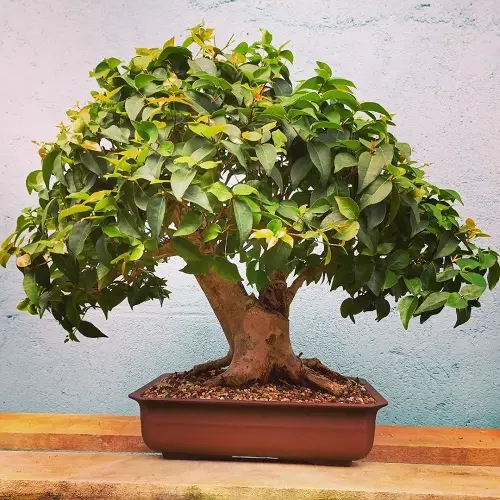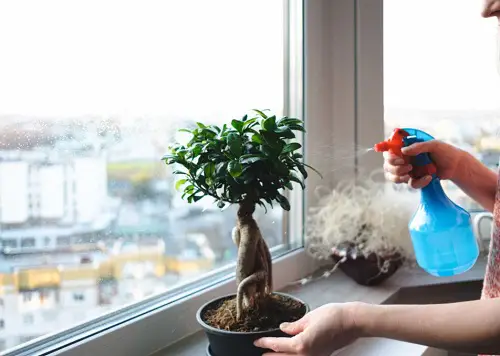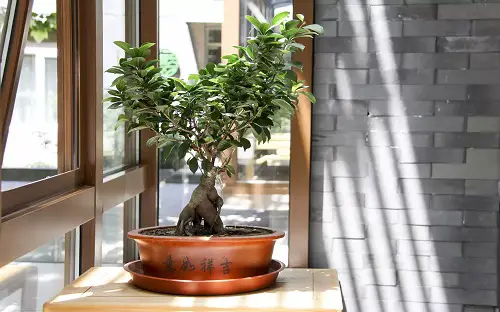If you’re a beginner, these Bonsai Tree Care Tips will educate you about the most basic aspects, helping you grow it properly!

If you are not sure about how to take care of a bonsai, then these expert Bonsai Tree Care Tips are all you need to ensure your little specimen shines with all its healthy glory!
How to Take Care of a Bonsai Tree?
Before you ask how to care for a bonsai tree, you will have to understand the basics of indoor bonsai tree care. Taking care of these plants is a lot different from the other houseplants and treating these plants like any other would be a grave mistake.
When it comes to bonsai tree care, a lot of factors like light, watering, soil, and other aspects need to be taken care of and we will explain each of them in detail.
Bonsai Tree Care – Location

The most important thing in Bonsai Tree Care is the location of the plant. People who ask – how to care for a bonsai tree need to understand that the location of the plant plays a vital role in its health.
The ideal location for growing Bonsai depends on several factors such as climate, species of tree, and time of the year. By thumb rule, the outdoor varieties should be given at least 5-6 hours of sun exposure daily and protection from cold winds.
For indoor Bonsai Tree Care, make sure to place them on a South-facing window, where they get plenty of bright and indirect light.
Bonsai Tree Care – Right-Growing Medium

The right Bonsai tree soil mix should be nutritionally rich and well-drained to prevent root rot while holding enough water to meet the tree’s needs. This is the most vital Bonsai Tree Care tip that you have to follow.
Ideally, people who grow Bonsai trees swear by a mixture of lava rock, pumice, and Akadama in a 1:1:2 ratio. When you want to improve the drainage of your mix for a wet climate, increase the proportion of lava rock, and if you want to increase water retention during a dry climate, use more Akadama.
Bonsai Tree Care – Organic vs. Inorganic Soils
Before you ask –how to care for a bonsai tree, it is important that you understand the types of soil that you need to use. It plays a crucial role in Bonsai Tree Care.
Most of the soil mixes you’ll come across are labeled as organic or inorganic. Organic soil is rich in plant matter like leaves and bark. It is rich in nutrients, but it breaks down easily, reducing drainage and causing long-term problems. However, inorganic soil has components like lava and clay that drain faster and maintain good aeration. However, they offer a poor complement of nutrients.
Bonsai Tree Care – Soil Recommendations
1. Deciduous Bonsai
50% Akadama
25% Lava rock
25% Pumice
2. Evergreen Bonsai
33% Akadama
33% Lava rock
33% Pumice
Bonsai Tree Care – Choosing a Pot
Selecting a pot is one of the most important aspects of Bonsai Tree Care. For this, you’ll need to follow certain guidelines:
1. Gender
When it comes to how to care for bonsai tree, determining whether you’re dealing with a male or female bonsai tree is the first step in choosing a pot. Masculine bonsai trees are mature with thick bark, dense branches, and sturdy trunks. Feminine ones have a cascading or graceful structure with smooth bark and light-colored branches.
Masculine pots are square, oblong, or rectangular with sharp edges. They have intricate carvings and are often covered by a lip on the rim. More often than not, they’re elevated and filled with rocks.
Feminine pots, on the other hand, are oval, or cylindrical, with a smooth texture and flat edges. They often showcase symbols and lack elevation.
Both have their own advantages in Bonsai Tree Care.
2. Size
When it comes to size, the thumb rule is that if the bonsai’s height is more than its width, the container length should be at least two-thirds of the tree’s height. However, if the width is more than the height, the container length should be two-thirds or more than the tree’s width.
Also, if the tree is masculine and has dense foliage, consider a wider pot with little elevation. Flowering and fruiting bonsai have rapidly growing roots and thus should be grown in deeper pots. Do remember to keep these points in mind for the right Bonsai Tree Care.
Bonsai Tree Care – Watering

Watering is the most critical component of a Bonsai Tree Care regimen. How often you water depends on several factors such as the size and species of the tree, size of the pot, season, and soil mix.
In other words, it’s practically impossible to lay down ground rules for watering Bonsai. However, never let the growing medium dry out completely because of the constricted root system of these plants.
1. When to Water?
The right Bonsai Tree Care depends a lot on how you water the plant. Stick your fingers in the soil around one or two centimeters deep. If the soil feels dry all the way to that depth, you know it’s time to water. Don’t wait till it’s completely dry though.
If the surface appears hard on hot afternoons, consider submerging the pot in water for 10-15 minutes. That should restore the lost moisture.
When the soil looks light brown and barely wet, pour water all over the surface till it drains out the pot through the holes beneath.
2. How Often to Water?
Remember, bonsai trees have constricted root systems that need a constant supply of water. Also, the hotter the weather or the location, the more water they’ll use.
As long as you keep checking the soil now and then, and allow the soil to get barely damp in-between waterings, you’re fine. This is the most vital Bonsai Tree Care that you have to follow.
3. Symptoms of Under Watering
- Dry leaves that tend to droop
- Shriveled leaves that have become papery and brittle
- Death due to dehydration
Solution: Allow mildly dehydrated bonsai tree to sit in water for a few minutes. It will re-bud in one month or so. Do not be tempted to over-water during this time. Mist new buds to encourage growth.
4. Symptoms of Over Watering
- Prolonged over-watering causes root rot, where the roots are shriveled and infected, unable to transport water
- The wilted appearance of the Bonsai
- Black-tipped leaves
Solution: Repotting an over-watered bonsai is the only option.
Using sharp shears, remove dead, damaged parts of the bonsai. Ensure the cambiums on the remaining parts are green and healthy. Gently lift the bonsai from its old container, shake off the loose soil and repot it.
5. Effect of Soil Mixture on Watering
The experts on Bonsai Tree Care swear by the type of soil used to grow the tree. The soil mixture determines how often bonsai needs watering. Mostly, a mixture of lava rock, pumice, and gravel works fine.
Using a mixture with water-retentive components such as compost or Akadama is good for those who are too busy to water regularly.
Bonsai Tree Care – How to Water?
There are two expert-recommended ways to water Bonsai that you have to follow during Bonsai Tree Care.
1. Overhead Watering
During Bonsai Tree Care, this method involves using a hose or a watering can to supply a regulated dose of water to carefully hydrate the soil without causing damage to the Bonsai.
2. Immersion Method
The method involves dunking the entire tree into a bucket full of tap water. Make sure the water reaches one inch up to the trunk.
If the root ball starts bubbling as soon as you submerge the tree, that indicates the Bonsai is water-deprived. When the bubbles reach the surface, you know it’s time to stop.
It is one of the most important Bonsai Tree Care tips that you have to follow.
Bonsai Tree Care – Misting vs. Watering

In Bonsai Tree Care, misting is a quick way to increase humidity for outdoor bonsai. Misting in the evening is recommended in the hot weather, but it should never be seen as a replacement for watering.
However, misting indoor bonsai trees is not the most effective measure to increase humidity. In addition to misting, there are other ways of creating a humid atmosphere for your bonsai tree, for example, placing the pot on a shallow tray containing pebbles and water.
Check out these tips to learn how to increase humidity indoors
Bonsai Tree Care – Fertilizing

People who ask how to take care of a bonsai tree, need to take care of the fertilization of the plant. It is also one of the most important aspects of Bonsai Tree Care.
Bonsai trees need regular feeding during the growing season. While normal plants can employ their root system to reach out into the soil and obtain nutrients. The bonsai tree has a space-constrained root system that needs constant replenishment to maintain a healthy nutritional complement.
1. When to Apply Fertilizer?
As said before, bonsai trees need feeding during the growth period, i.e., from early spring to late fall or year-round at regular intervals in frost-free climates.
Mature trees need to be fertilized less often, depending on the species and overall health, while young indoor trees need regular feeding around the year.
Do not fertilize repotted Bonsai during the first month, and infected trees should also be treated first. Keep this Bonsai Tree Care tip in mind for the best growth.
2. Fertilizing Different Types of Bonsai Trees
- Fertilize both deciduous and evergreen bonsai trees once a month with granular fertilizer. If using a liquid fertilizer, feed twice a month. If required, fertilize your bonsai trees more often in spring and summer–every 7 to 10 days in weak strength. This will ensure your Bonsai Tree Care approach is top-notch.
- Instead of a regular fertilizer, use a zero nitrogen fertilizer like 0-10-10 for deciduous trees, when the leaves have fallen in the fall. Stop fertilizing in winter during the dormancy period.
- Keep fertilizing evergreens and tropical and subtropical bonsai trees in the fall and winter. In winter months, keep them indoors to protect them from low temperatures and a cold draft. This is a vital Bonsai Tree Care tip that you must follow.
- Many cool climate evergreen specimens also initiate their dormant period in harsh winter months from the end of December, January, to mid of February and curtail all the new growth. Observe and stop feeding them during that time.
- Tropical bonsai trees don’t go into dormancy, protect them in cool weather and fertilize them with liquid fertilizer occasionally in winter–Once a month. If growing in a warm climate, avoid this Bonsai Tree Care rule.
3. When to Avoid Fertilizing
Never Fertilize a bonsai tree that is dry, looks infected, diseased, dehydrated, or shriveled up. Additionally, wait till it breaks dormancy and at least a month after repotting before you start feeding it again. Bottom line is that you should never feed a bonsai tree that is under stress. Mark this as a vital Bonsai Tree Care tip.
4. Which Fertilizer to Choose?
Using a Bonsai fertilizer with the right NPK ratio is just as important as knowing when to apply it. Take a look at the following Bonsai Tree Care feeding tips:
- Use any nitrogen-rich fertilizer like N-P-K 10:6:6 in spring.
- Use a balanced fertilizer with NPK 6:6:6 or similar numbers like 10:10:10 or 20:20:20 in summer and a low nitrogen fertilizer with N-P-K 3:6:6 in fall (autumn).
- Using a balanced fertilizer during the growing period while slowly reducing the strength towards the dormant months is advisable. This is the most simple Bonsai Tree Care feeding tip you can follow.
- Encourage blooming with a fertilizer that is high in phosphorous, like NPK 6:10:6.
- With aged trees, use a lower nitrogen content fertilizer.
Bonsai Tree Care – Liquid vs. Granular Fertilizers

Liquid fertilizers are more penetrable and easier to apply. However, they need more frequent applications to work as they wash away gradually as you water the Bonsai tree.
Granular fertilizers are time-based, they release the nutrients slowly and stay in the soil for a long time. Basically, both types of fertilizers work well and bonsai gardeners prefer using them in balanced proportions.
Bonsai Tree Care – Repotting

In the right Bonsai Tree Care, know that it’s time to re-pot when you notice the roots clustered around the root ball or if roots are visible on the surface of the soil. Bonsai trees in shallow pots may also need early repotting.
Repotting should be done during the first or second week of spring when your tree is about to suspend its dormancy. Repotting during this time minimizes damage because the tree doesn’t have to carry the extra burden of dense foliage. The conducive weather of early spring ensures faster growth, promoting the healing of damaged roots if any.
The frequency of repotting depends on the species of tree and the size of the pot you’re dealing with. Fast-growing bonsai trees should be repotted every year or two, while mature ones can be repotted every three to five years.
The growth speed of every tree depends on many factors, so be sure to check your trees in early spring for signs of repotting.



